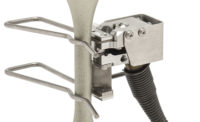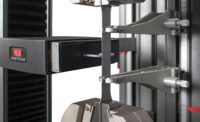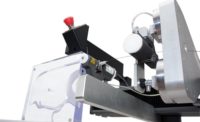Composite materials are being used in an ever-increasing variety of products and applications, as more and more industries realize the benefits that these materials offer. As the demands for light-weight composite structures for aerospace, ground transportation, and environmentally sustainable energy systems develop, so do the mechanical testing requirements for composite materials, components and structures.
Full characterization of the properties of anisotropic and inhomogeneous composite materials, for use in demanding structural applications, requires a wide range of mechanical tests. Determination of bulk properties requires tension, compression and shear tests. In qualification and materials development, other test types are used to explore more complex properties, such as open hole tension/compression (OHT/OFC), inter-laminar fracture toughness, compression after impact (CAI), and fatigue. Tests need to be conducted over a range of temperatures on materials that may have been conditioned in a variety of environmental conditions such as high humidity and immersion in fluids.
Composites’ testing for aerospace applications is, undoubtedly, one of the most demanding areas of testing. Laboratories undertaking composites testing for aerospace applications face a number of challenges. Four significant challenges are:
- Ensuring all that tests are conducted in compliance with the wide range of standards
- Achieving, maintaining, and being able to demonstrate accurate alignment of grips and fixtures
- Changing test fixtures quickly and efficiently in order to cover a wide range of tests while maintaining high productivity
- Maintaining the correct test environment
COMPOSITE TEST STANDARDS
Composite tests have been standardized by a number of organizations. The main international composite testing standards are those maintained by ASTM, ISO, CEN (European Committee for Standardization). In addition to the international standards, there are a number of manufacturer’s proprietary standards in widespread use including the BSS series from Boeing and the AITM series from Airbus. There are other obsolete standards that are still being used today including those published by SACMA (Suppliers of Advanced Composite Materials Association), CRAG (Composites Research Advisory Group), and AECMA (Association Européenne des Constructeurs de Matériel Aérospatial). In many cases, the test methods described by different standards are basically the same, but there are significant differences in the specimen and fixture dimensions. In addition, auditing bodies such as Nadcap further define performance criteria, e.g. alignment for the testing equipment.
TENSILE TESTING
In-plane tensile testing of plain composite laminates is the most common test. Tensile tests are also performed on resin impregnated bundles of fibers (“tows”), through thickness specimens (cut from thick sections of laminates), and sections of sandwich core materials.
Examples of common standards for the tensile testing of laminates are ASTM D 3039, EN 2561, EN 2597, ISO 527-4, and ISO 527-5. The specimens are parallel sided with bonded tabs to prevent the grip jaws from damaging the material and causing premature failures. Gripping mechanisms include manual and hydraulic wedge grips. For demanding aerospace testing, hydraulic wedge gripping solutions are generally preferred because of their controllability and repeatability. However, well-designed mechanical wedge grips can also provide good levels of alignment. Hydraulic grip solutions for non-ambient testing often place the hydraulic components outside the temperature chamber for safety and reliability.
Accurate alignment of the grips and specimen is very important when testing composite materials due to the fact that the anisotropic properties, such as the modulus and strength, of the material differ depending on the direction of the applied stress and are often brittle in nature. Adjustable alignment fixtures are available to ensure that testing systems meet the alignment criteria required for reliable composites testing and as required by specific audit programs used by aerospace industries, such as Nadcap AC7122/1. To be effective, alignment fixtures need to allow adjustment of both concentricity and angularity while the machine load-string is under load. The accepted method of checking for alignment under load is to use a strain gaged “alignment cell or specimen.” The alignment cell should have dimensions that are as close to the specimens being tested as possible. Typically the alignment cell will be fitted with two or three groups of four strain gages. Additionally, software is available that will provide a display of both the bending and the concentricity and angularity errors. This software identifies the adjustments that are required and displays, in real time, the effect of the adjustments, enabling accurate machine set-up in minutes.
When using well-aligned grips, it is recommended that the grips are permanently left in place on the testing machine and that, when needed, test fixtures including compression platens and bend fixtures are mounted on the grips using adapters.
Strain measurement for composites tensile testing is usually performed using either an extensometer or a bonded strain gage. The use of an extensometer is generally preferred as strain gages involve additional labor and cost. However, in both case, it is recommended to use an average strain value based on measurements on both sides of the specimen in order to correct for errors caused by specimen bending.
COMPRESSION TESTING
Composite compression test methods need to provide a means of introducing a compressive load into the material while preventing it from buckling. Most composite materials are produced in the form of laminate panels, and hence, the material being tested will be in the form of a relatively thin and flat rectangular test specimen.
There are three methods of introducing a compressive load into a test specimen:
- End loading: all of the load is introduced into the flat end of the test specimen
- Shear loading: the load is introduced into the wide faces of the test specimen
- Combined loading: A combination of shear and end loading is used
There are two methods for preventing buckling of a test specimen:
- Use of a test specimen with a short, unsupported gage length
- The use of lateral support along the length of the specimen
In practice, there are several different compression test methods that utilize all possible combinations of the above methods of load introduction and buckling prevention.
All compression fixtures are required to have good axial alignment and a high lateral stiffness in order to provide and maintain accurate alignment under the lateral loads that can be generated by a compression test. Bending will have a significant effect on test results and most of the compression test methods include a value for the maximum allowed specimen bending. Common composites compression test standards include: ASTM D695, ASTM D3410, ASTM D6641, ISO 14126, and prEN 2850.
SHEAR TESTING
In-plane shear properties can be measured on a tensile test specimen with a ±45 degree fiber orientation. The specimen’s axial and transverse strain is measured using either strain gages or a biaxial extensometer. Standards for this test include ASTM D3518 and ISO 14129.
The inter-laminar shear strength test (ILSS), sometimes referred to as short beam shear, is a simple test performed using a small specimen loaded in a three point bend configuration. The ratio of the specimen thickness to the support span is high; this helps generate large shear loads along the center line of the specimen. ILSS standards in common use include: ASTM D2344, EN2563 and ISO 14130.
Other laminate shear test methods include the rail shear (ASTM D4255 and ASTM D7078) and V-notched beam (ASTM D5379). Shear tests for sandwich core materials include: loading parallel to the plane of the facings (ASTM C273) and short beam shear (ASTM C393).
COMPRESSION AFTER IMPACT TESTING
Damage tolerance is a major concern with composite laminates. Compression after impact (CAI) testing provides a measure of damage tolerance. The CAI test is usually conducted on a rectangular laminate panel. The test consists of two parts:
First, the panel is clamped around the periphery and then subjected to a controlled impact in the center of the panel (A drop tower is required to provide the impact),
Secondly, the panel is then placed in a jig and subjected to an edgewise compressive load until it fails. The failure load gives an indication of the residual strength of the panel after the impact damage. CAI standards in use include: ASTM D7136/D7137, ISO 18352, and prEN 6038.
FATIGUE TESTING
Compared to the large number of well-defined “static” tests on composite materials, fatigue testing of laminates is much more open. It’s important to have accurate alignment and correct gripping to avoid failures near the grip jaws. Also, high lateral stiffness is paramount to prevent buckling in tests that include compressive loading. It should be noted that some of the anti-buckling guides used in “static” testing are problematic if used in cyclic testing due to friction effects. When conducting fatigue tests on polymer composites the maximum test frequency is limited by need to limit the temperature rise in the test piece e.g. the maximum temperature rise recommended by the ISO 13003 fatigue standard is 10 C.
Fatigue testing software is now available which is capable of monitoring the test specimen temperature and intelligently adjusting the test frequency to minimize the test duration while ensuring that the specimen does not overheat. Finally monitoring damage and defining failure of a composite material in a fatigue test is not straightforward—a common means of tracking damage is by monitoring the change in specimen stiffness during the test, but de-lamination damage has little effect on the tensile stiffness.
OTHER MECHANICAL TESTS
A variety of other standardized mechanical tests on composite materials include: flexure testing, tension and compression tests on specimens with open and closed holes, bearing strength tests, and inter-laminar fracture toughness tests.
TEST ENVIRONMENTS
The most common test environment for composite materials is temperature (generally in the range -80 to 250 C). Specimens are often pre-conditioned in different environments prior to testing. Pre-conditioning is often in hot/wet conditions; however exposure to fluids (e.g. water, fuel, and hydraulic fluids) are also used. The time taken for polymer composite materials to achieve equilibrium with a conditioning medium is usually a few days or weeks. So for short duration testing including tensile testing of pre-conditioned composite materials can generally be conducted in a temperature-only environment. Chambers designed for testing at low and high temperatures are generally equipped with forced convection for heating and liquid nitrogen injection systems for cooling
In conclusion, the mechanical testing of composite materials is complex, involving a range of test types, a plethora of standards, and the need to condition and test in a variety of different environments. Life is made easier by well-aligned test machines and grips, interchangeable test fixtures, and test software with pre-configured test methods.





